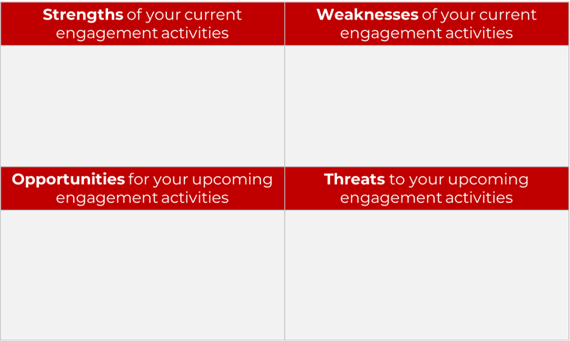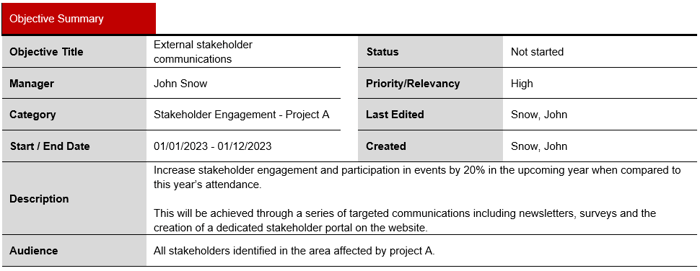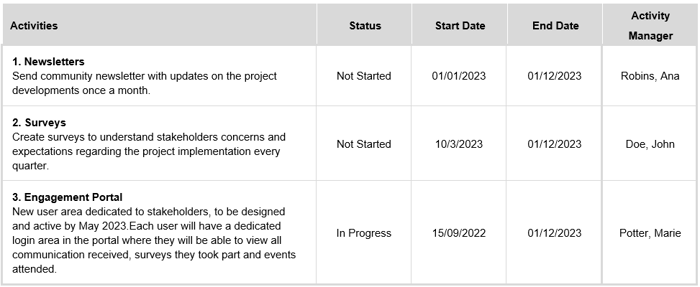It is known that implementing a strategic plan increases the chances of a project being completed successfully. However, with the ever-changing world we live in and the challenges in daily operations, it’s easy for any plan to fall by the wayside – and that’s also the case with stakeholder strategy plans.
Stakeholder engagement managers and project managers can spend a lot of time creating a stakeholder strategy plan, only to have it months later gathering dust in a cabinet or forgotten in a “strategy” folder somewhere on the computer.
Effective strategy plans are meant to be revisited and monitored. Otherwise, how can you tell if you’re getting close to achieving the objectives you’ve set in the first place?
Create a stakeholder strategy plan that will set you up for success throughout the year. Here we’ll cover the steps you need to build yours:
- Why develop a stakeholder strategy plan?
- Creating a stakeholder strategy plan
- Stakeholder strategy plan example
- Stakeholder strategy plan streamlined
Why develop a stakeholder strategy plan?
A stakeholder engagement strategy plan must be seen as a “living” document, a blueprint you will come back to many times throughout the year.
Revisiting your stakeholder strategy plan frequently is important as it will help you:
- Keep track of the activities you must accomplish;
- Have team members follow a consistent plan;
- Reach your proposed objectives and outcomes.
Creating a stakeholder strategy plan
Understand your organisation’s objectives
Plans are usually broken down into key areas, or objectives. But before settling on the stakeholder strategy objectives, you must first understand your organisation’s mission and objectives.
- What are your organisation’s objectives and long-term goals?
- How can a stakeholder engagement strategy plan support corporate objectives?
Your stakeholder strategy plan should be aligned with your organisation’s vision and include:
- The methods that will be used to communicate with the stakeholders;
- Ways to influence stakeholders and support stakeholder buy-in;
- Methods to manage difficult stakeholders and negative feedback.
Know your stakeholders
Once you know the direction your organisation is heading to, it is time to bring your stakeholders into the planning process.
Identify your stakeholders: consider all the stakeholders that may have any sort of interest or could be impacted by your project or organisation.
Stakeholder identification is important to ensure that no one is left out, helping avoid future issues with stakeholders turning against your project and alleging they were not informed about it.
Map your stakeholders: the stakeholder mapping process will help you better understand your stakeholders and their various levels of power and influence.
The mapping process allows you to be more strategic, communicating and involving each stakeholder group the right way.
You can use the free template available in our stakeholder engagement guide to map out your stakeholders, their levels of influence and interest and the communication tools you will consider using.
Have you done this stakeholder identification and mapping before? It might be time to review it.
Different projects within the same organisation will have different stakeholders. Moreover, stakeholder interests change with time, and you may find there are more stakeholders to be included in your plan.
Analyse your current engagement activity
It is likely you are already engaging with your stakeholders through some sort of engagement activity.
Go over the existing relationships with your stakeholders, review all the feedback you have received and list their interests and key issues, as well as the current engagement activities being used to communicate with them.
You can apply a SWOT analysis here to better grasp what’s working and what needs attention:

After summarising your existing relationships and doing a SWOT analysis, determine:
- What are the strengths and opportunities you can build on and use to improve your stakeholder engagement?
- What are the issues and biggest threats you must mitigate or minimise, so they will not hinder your engagement effectiveness?
The answers to these questions will provide you with the priorities for your plan. For example, the opportunities you intend to focus on or the key issues you need to eliminate.
Set your stakeholder engagement strategy objectives
The objectives you will set for your stakeholder strategy plan must reflect the priorities you have just identified, as well as your organisation’s objectives previously identified.
Also, consider using the SMART method (Specific, Measurable, Attainable, Relevant, Time-bound). This framework will help you set clear objectives to focus on that you will be able to analyse later.
Your strategy plan can include as many activities as you need to help you achieve your objectives.
Setting up a yearly plan is the ideal timeframe for implementing a series of engagement activities to nurture stakeholder relationships and measure its results.
Stakeholder strategy plan example
Here is an example of an external stakeholder communications strategy plan created using Tractivity's strategy plan module you can use as a reference to design your own strategy:


Add all the objectives and activities into a document you can easily access and update.
Download the template from the example above in a Word document format here.
Implement your stakeholder strategy plan
Stakeholder strategy plans are not a “set and forget” type of planning.
You should revisit your strategy document on a frequent basis to update the evolution of the activities added, hold your team accountable and make any changes that are needed along the way.
By doing so, not only will you be able to analyse and report on everything you have done during the year, but also use the insights to improve and refine your next engagement strategy planning.
Your stakeholder strategy plan streamlined
A stakeholder engagement system provides you with the best tools to create and keep your stakeholder strategy plan on track while eliminating data safety and multiple document version issues.
Discover how centralising your planning, engagement and reporting activities in a proper system like Tractivity can save you and your team hours of work and effort. Contact us to learn more!


